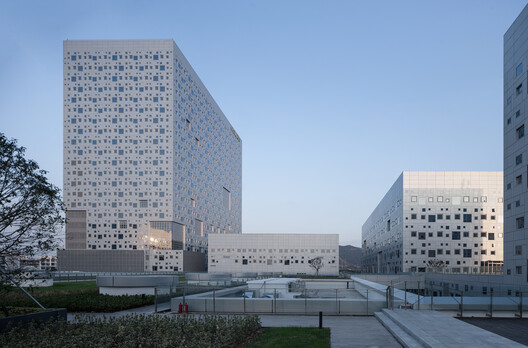architectural design and layout
The “Taihu Cloud Valley” Digital Industrial Park exemplifies sleek, modern architectural innovation, fusing minimalist design with practicality. The layout focuses on achieving a seamless interaction between the constructed spaces and the natural setting, a challenge in a tech park environment. The design smartly segments the area into two primary sectors—one dedicated to the digital industrial centre and the other filled with commercial and community facilities. This approach transforms the park into a vibrant, multi-purpose locale rather than merely a workspace.
The buildings are low-rise, a hallmark of contemporary architecture, which helps maintain a clean and unobtrusive skyline. The glass facades not only optimize natural illumination but also lend the structures a lightness, giving the impression that they are floating within the surroundings. As if to convey, “Why obstruct the vista when you can blend into it?”
Walkways and green corridors meander throughout the park, linking the different areas and promoting foot traffic. However, it’s more than just a means to traverse from point A to point B; the designers have prioritized creating venues for people to gather, unwind, and engage collaboratively. Envision open plazas, rooftop gardens, and shaded courtyards—ideal spots for fresh air between meetings or a cheeky midday coffee.
The layout strikes a careful balance between form and functionality, nodding to the evolving landscape of work environments. It’s versatile and changeable and crafted to stimulate innovation while maintaining visual appeal. After all, who says a tech park can’t be pleasing to the eye?
integration of technology and sustainability
In merging technology with sustainability, the “Taihu Cloud Valley” Digital Industrial Park doesn’t just meet the criteria—it potentially redefines them. The project exemplifies how state-of-the-art technology can be intricately integrated into a sustainable, eco-friendly setting. This one exudes warmth, unlike many tech parks that might seem stark and uninspiring.
To begin with, innovative technology is omnipresent. The park aims to minimise its carbon footprint by utilising energy-efficient HVAC systems that respond to real-time weather fluctuations and responsive lighting that activates only as necessary. It feels as if the buildings are intelligently managing energy use, conserving power effortlessly. And let’s face it, who doesn’t appreciate a touch of automation when it aids in protecting the planet?
The park also harnesses renewable energy sources, incorporating solar panels into its overall design. It’s not a case of merely placing a few panels on the roof and calling it good; here, they are integral to the architecture. The solar arrays are meticulously positioned to enhance energy capture while providing shade to certain building sections—a win-win for both sustainability and comfort.
Water conservation is another significant priority. The park features a rainwater harvesting system for irrigation and cooling, ensuring every drop is effectively used. This is akin to having an internal water recycling initiative, quietly promoting resource conservation while keeping the landscape flourishing and vibrant.
Moreover, green spaces are prevalent, serving aesthetic purposes and functioning as part of the park’s environmental strategy. These green corridors and rooftop gardens mitigate the urban heat island effect, enhance air quality, and offer natural habitats for local fauna. It’s sustainability paired with tranquillity—everyone could use a zen during their workday.
The “Taihu Cloud Valley” doesn’t merely pay lip service to sustainability. It embodies a fully realized integration of technology and eco-conscious design. This space fosters optimism about the future—both for architecture and for the planet as a whole.
